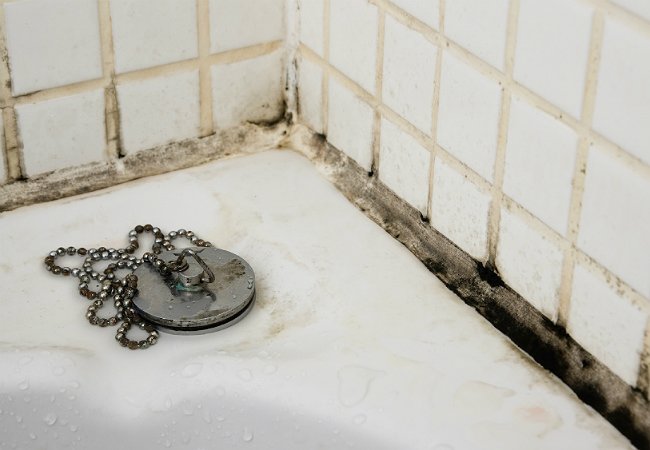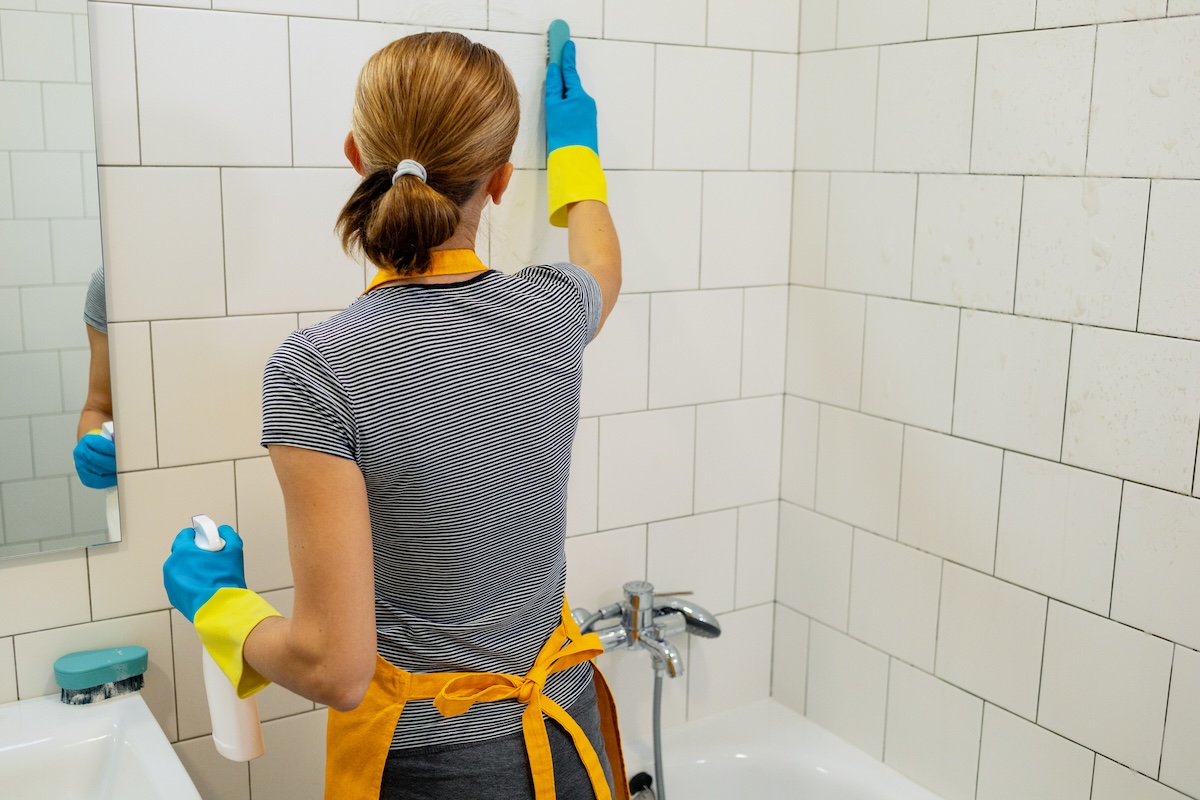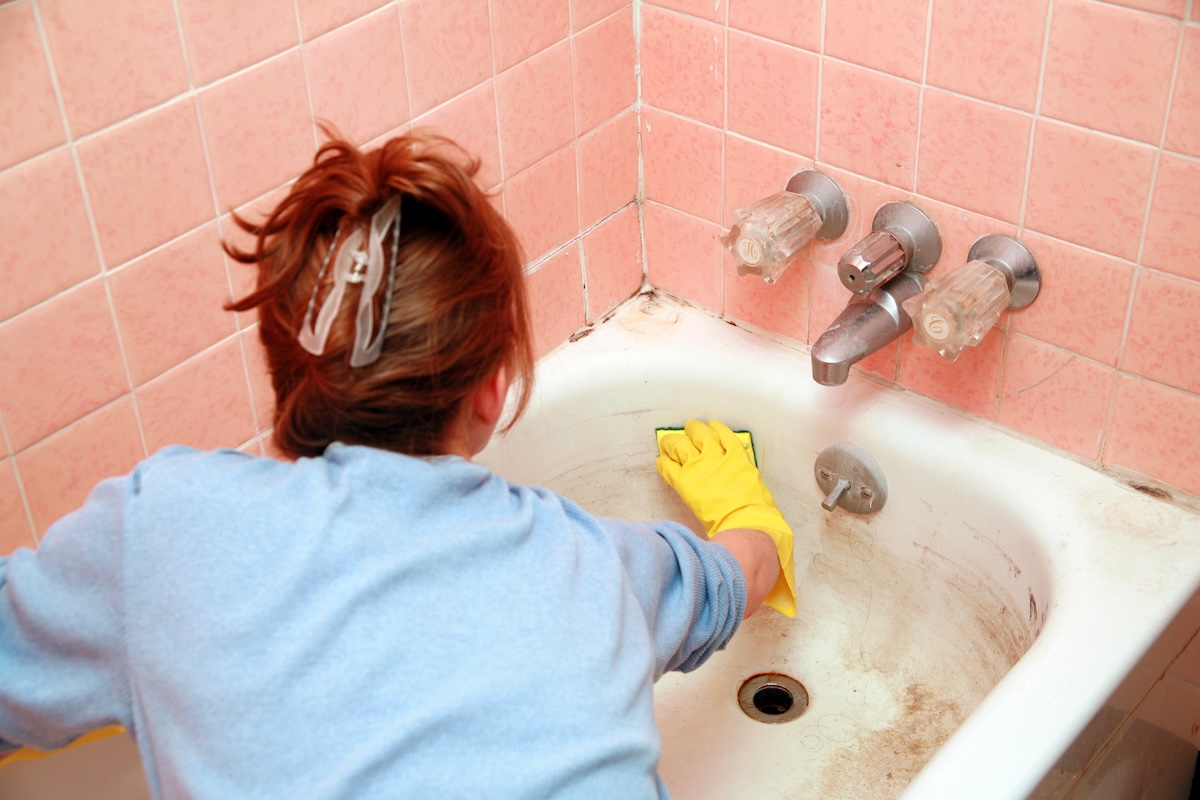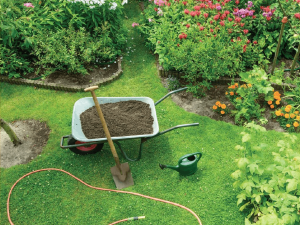We may earn revenue from the products available on this page and participate in affiliate programs. Learn More ›
People spend about 90 percent of their time indoors, so keeping indoor air healthy is a must.
Mold is a fungus that’s plentiful in the natural environment and, when conditions are right, indoors as well. The bathroom is damp, and often warm, so it can be a favorite spot for black mold to grow.
According to Donald Weekes, a certified industrial hygienist in Ontario, Canada, and a member of the American Industrial Hygiene Association (AIHA) Indoor Environmental Quality Committee, “there is something in the neighborhood of 200,000 different types of mold.” Since it’s natural, alive, and goes airborne, mold can happen just about anywhere, Weekes says. Read ahead to learn what conditions support mold growth in your home, how black mold can make you sick, and what to do about black mold in a bathroom.
What is black mold?

The black mold species Stachybotrys chartarum is an aggressive and highly toxic mold variety that might be best removed by a professional. It’s among the world’s 10 most hazardous fungi. “Black mold, in particular, produces mycotoxins,” says Kenny Key, CEO and founder of Lead and Mold Detectives in New York. Those can lead to health problems, especially in the respiratory system.
It can be difficult to tell whether a fungus in your bathroom is black mold vs. mildew or another mold variety. But even as you consider the health effects and identification markers of black mold below, note that the experts we consulted agree that you should address any signs of mold, regardless of type. ”If you spot any mold in your bathroom—whether black or not—it’s important to take action immediately,” says Laura Linn Knight, author of The Toxic Mold Solution: A Comprehensive Guide to Healing Your Home and Body from Mold. Leaving any mold in place too long, especially without addressing moisture, can increase the chance the problem will progress to black mold.
Black Mold’s Impact on Health
Exposure to any mold over time can lead to health effects. The type and range depend on “the type of mold, the level of exposure, and the individual’s sensitivity,” says Knight. Potential health effects of mold exposure and black mold symptoms include:
- Respiratory issues—black mold exposure can cause or worsen asthma. Other signs are wheezing, coughing, sneezing, shortness of breath, and sinus infections.
- Allergic reactions, such as skin rashes, watery eyes, and even swollen eyes.
- Headaches, such as migraines
- Fatigue, dizziness, or vertigo
- Brain fog and difficulty concentrating
- Abdominal pain, nausea, bloating
- Mental health effects such as anxiety or depression.
The mycotoxins in black mold “can cause chronic fatigue, nausea, vomiting, and neurological symptoms like dizziness, confusion, and sometimes memory loss,” says Key. Knight says that mycotoxins can interfere with brain function, “contributing to mood swings, memory problems, and increased stress levels.” If you don’t address mold exposure like black mold in the shower, you can have “chronic, long-term health issues, including chronic respiratory problems and neurological effects,” says Knight.
How to Identify Black Mold in the Bathroom

Before knowing how to get rid of black mold in the bathroom, learn what conditions support mold growth. First, Weekes says to look for the three things mold needs to thrive: mold spores, a porous surface they can latch onto, and high humidity/moisture. Drifting through the air, mold spores eventually land on a moist surface amenable to mold, like cellulose, and “they’ll most likely land on that surface and grow,” says Weekes.
To tell the appearance of black mold from other molds, look for a dark patch that forms in a circular pattern. “Black mold typically is darker in color, a black or greenish-black, and usually looks wet,” says Key. “Black mold also has a very distinct musty smell that can help in identification,” he says.
Still, black mold could lurk under bathroom floors or inside walls. The only sure way to identify black mold is to take a sample and test it—either by asking professionals to come in or by using a black mold test kit. Once you confirm the bathroom mold type and extent of the problem, you can learn how to remove black mold safely or seek professional help.
Before You Begin
Cleaning mold requires that you be near the spores. If you attempt to remove black mold, “you need to wear protective gear,” says Key. This includes gloves, goggles, an N95 respirator mask, and long sleeves. “Make sure you have proper ventilation in the area in which you’re working,” Key advises. Further, use similar caution when turning to various cleaning products; follow all instructions on the container and never mix chemicals, especially ammonia and bleach.
Follow these protective measures to minimize exposure. If you notice any health effects from being near the black mold, it’s best to stop working and have a professional take over. Likewise, if you are uncertain about the type of mold or extent of the problem, notice significant water damage, or see that black mold covers more than 10 square feet of surface area, turn to a professional remediator instead.
How to Clean Black Mold From Bathroom Surfaces
SUPPLIES
N95 respirator mask
Rubber gloves or chemical-resistant gloves
Eye goggles
Distilled white vinegar
Detergent or antifungal cleaner
Hydrogen peroxide
Rags, sponges, or a scrub brush
BleachAmmonia
Without testing the mold, it can be difficult to know in advance what works best to kill black mold or another type. If uncertain and facing a small amount of stain, start with milder household products and move on to harsher ammonia if necessary. “Generally speaking, it’s the simplest product that works best,” says Weekes. When deciding how to eliminate mold in bathroom fixtures or walls, always consider the surface type, partly to avoid abrasive tools that might scratch the surface. In addition, porous surfaces can absorb all liquids, as well as the mold spores you can see.
How to clean hard surfaces, like ceramic tiles and bathroom countertops
Follow these directions for nonporous surfaces and fixtures include toilets, porcelain sinks, some shower or floor tiles, mirrors, and vinyl shower curtains. Unless they are sealed well, grouts and many types of caulk are porous.
- Spray the area with your preferred safe cleaner, such as distilled white vinegar or a mixture of vinegar and household detergent. You could also use undiluted 3% hydrogen peroxide or a commercial antifungal cleaner (follow manufacturer’s directions.)
- Let the cleaner sit for several minutes, then spray again just before wiping.
- After wiping the cleaner on the surface, check your results.
- If mold remains, spray again and scrub with a brush or abrasive scrubber. Dry the area thoroughly and assess whether the cleanup was effective.
- If mold remains after cleaning, clean the area again with ammonia and water (10 percent ammonia to 90 percent water).
- If the problem persist, you may need to call in the experts.
The easiest way to clean a vinyl shower curtain is to remove it and soak it in a large tub or container filled with water and about a cup of white vinegar (or bleach if the curtain is colorfast) for about an hour.
Only turn to bleach if necessary when cleaning black mold in bathrooms. Biocides like chlorine bleach kill living organisms such as mold, but the EPA does not recommend them for routine mold cleanup, even on nonporous surfaces. Weekes says the suggestion for years has been to use “water and about a 10 percent solution of ammonia.” You also can opt for a commercial product designed to kill mold, but check it carefully for safety precautions for surfaces and ventilation.
How to clean porous surfaces such as grout, ceiling tiles, and walls
Porous materials allow moisture—and mold—to penetrate their surfaces. In a bathroom, this might include wood, walls, wallpaper, carpet, unsealed grouts, caulk, and ceiling tiles. According to Weekes, mold will latch onto surfaces “made up of cellulose, like paper and wallboard.” He says the porous materials are “soft and chewy, which is why most problems are in walls and ceilings.” Even moisture-resistant wall materials like greenboard can take in mold if a shower surround or wall was not designed or installed properly or if excess moisture and mold have been allowed to sit on the walls.
Again, although you might see advice about using bleach to kill mold, apply that only to nonporous surfaces. “You don’t want to use bleach on a porous surface,” says Key. It could make the problem worse, since water in the bleach will penetrate the porous surface and add to moisture. Plus, Key says “black mold has a protective outer layer that bleach doesn’t penetrate effectively.”
- Select your treatment option. As with hard surfaces, start with the simplest or mildest option. White vinegar can help kill mold since it penetrates porous surfaces, and its acid could help rid crevices of mold.You also can use a commercial mold cleaner designed for multiple surfaces—follow package directions. If you have a small patch of black mold, skip right to the 10 percent ammonia and water solution.
- Spray the product on the affected area and let it sit for a few minutes.
- To avoid soaking the porous surface, wipe the area with a cloth or sponge, since a brush could harm porous surfaces.
- To avoid soaking the porous surface, Wring out the cloth or sponge if you dip it in a solution or as it becomes damp from wiping.
- Gently wipe the wall again with a wrung-out sponge or cloth dipped in clean water.
- To clean grout, dip a toothbrush in the cleaning solution and scrub the grout lightly before wiping with a cloth or sponge dipped in clean water and wrung out.
- Help the porous surface dry quickly by opening windows or directing fans toward the cleaned area.
- Let the wall dry for 24 hours if possible before checking results.
- If mold persists, repeat steps above or call in a pro.
According to the EPA, mold in ceilings and carpet can be difficult to impossible to remove since it fills the empty spaces and crevices of the porous materials. It is generally better to replace moldy ceiling tiles, carpet, or any large section of wall affected by mold.
When to Hire a Professional for Bathroom Mold Remediation
Tackling small spots of mold and mildew are easy DIY tasks and important bathroom maintenance to prevent black mold. But it’s important to know when you should call in a mold remediation professional or one of the best mold removal companies (such as ServPro or ServiceMaster Restore) instead. Professionals have the equipment and expertise to return your home to a safe state. They also can make recommendations on how to prevent mold from coming back in the future.
“Times to call in a pro are when it’s more than 10 square feet of mold, or if there is structural damage like mold growing on the walls, ceilings, or floors,” says Key. If mold is hidden behind walls, under carpet, or in your HVAC system, he explains, you need a professional remediation.
“Call in a pro…when it’s more than 10 square feet of mold, or if there is structural damage like mold growing on the walls, ceilings, or floors.”
— Kenny Key, CEO and founder of Lead and Mold Detectives
Your health and sensitivity also are factors, say Key and Knight. For example, those with asthma or allergies shouldn’t tackle black mold removal. “If you are sensitive to mold, I suggest hiring a professional to remove even a small amount of mold,” says Knight. Key adds: “If there is extensive water damage from flooding or minor damage in the bathroom from a leak,” you need a pro to treat that as well.
Key says to look for a licensed company in your state. All states have some type of certification for professional mold remediators. The AIHA maintains a list of industrial hygiene and environmental health and safety consultants. Mold inspection costs typically average around $656, but some companies will waive this fee if the customer hires them for remediation services.
Black mold removal costs start at about $1,223 and average about $2,300. Homeowners insurance may cover mold remediation, depending on the circumstances.
How to Prevent Mold in Your Bathroom

The best way to address black mold in your bathroom is to prevent mold from growing and to address any mold or signs of moisture damage immediately. “Prevention is a matter of maintenance more than anything else,” says Weekes. This includes making sure your home is sealed from outside moisture, that you’re not seeing condensation on windows, mold on windowsills, or water activity on surfaces, and that your home has adequate ventilation.
Clean your bathroom regularly.
Thoroughly clean the bathroom weekly; this consistent regimen should keep mold spores from taking hold and running amok. If you see signs of bathtub mold or other mold or mildew, rotate an antifungal cleaner into the routine at least once a month. Store a spray bottle of vinegar in the bathroom, then apply it and let it air-dry after every shower or bath. And don’t simply paint over mold on walls; take steps to clean the spores first.
Keep bathroom surfaces dry between uses.
To prevent black mold in the shower, use a squeegee to remove water droplets from the shower walls, then towel down glass doors and tile to remove the remaining moisture from those surfaces. It’s even helpful to dry the floor, dry off shampoo bottles, and hang damp towels elsewhere. Prevent black mold in a bathroom sink by wiping the basin out after each use. If you see signs of black mold in a bathtub or around it, be sure to drain it completely, wipe down wet edges if necessary, and check for signs of cracks in or black mold in bathroom caulk around the tub, shower, windows, or sink.
Take steps to eliminate moisture from leaks or a poorly sealed home.
“One of the main contributors to mold growth is excess moisture,” says Knight. “Fix any leaks in your bathroom plumbing or shower as soon as possible to prevent water from pooling or seeping into the walls,” she says. When the weather allows, open your bathroom window after a shower. Add moisture-loving plants like orchids or peace lilies to soak up some of the moisture and green up the space.
Running an exhaust fan for at least 30 minutes after fogging up the bathroom with showers or laundry if located there can help, but if you already have mold spores, use caution. “Most bathroom vents go directly up into the attic,” says Weekes. The attic probably has plenty of porous and cellulose surfaces for those spores to grow. If your exhaust fan vents to the outside, it can help. However, Weekes says, the best ventilation comes from your air conditioning system.
Use mold- or moisture-resistant construction.
“When renovating or maintaining your bathroom, consider using mold-resistant products,” says Knight, who says that new products like mold-resistant paperless drywall, vapor barriers or retarders, are always coming on the market. Opt for nonporous surfaces when possible, and ensure that all caulks, grouts, and joints are properly sealed to prevent water from seeping through cracks.
Final Thoughts
According to Weekes, cleaners and other efforts help control mold, but you can’t be completely free of this living organism. “Mold has survived for hundreds of thousands of years. Anything that you can throw at it will not be completely effective,” he says. Still, managing moisture, regularly cleaning spores from surfaces, and getting rid of any black mold with these steps or through professional remediation can help. If black mold returns or spreads after you try to kill it, turn to a licensed mold removal company to help eliminate existing mold damage and correct issues like moisture or poorly constructed shower walls that support its growth.


